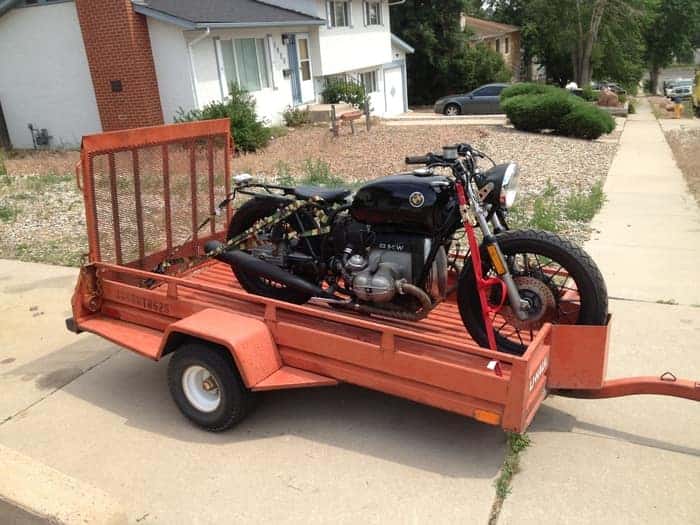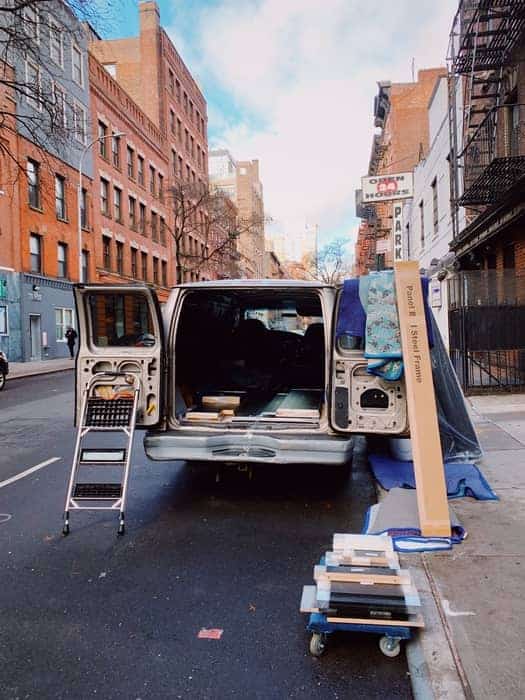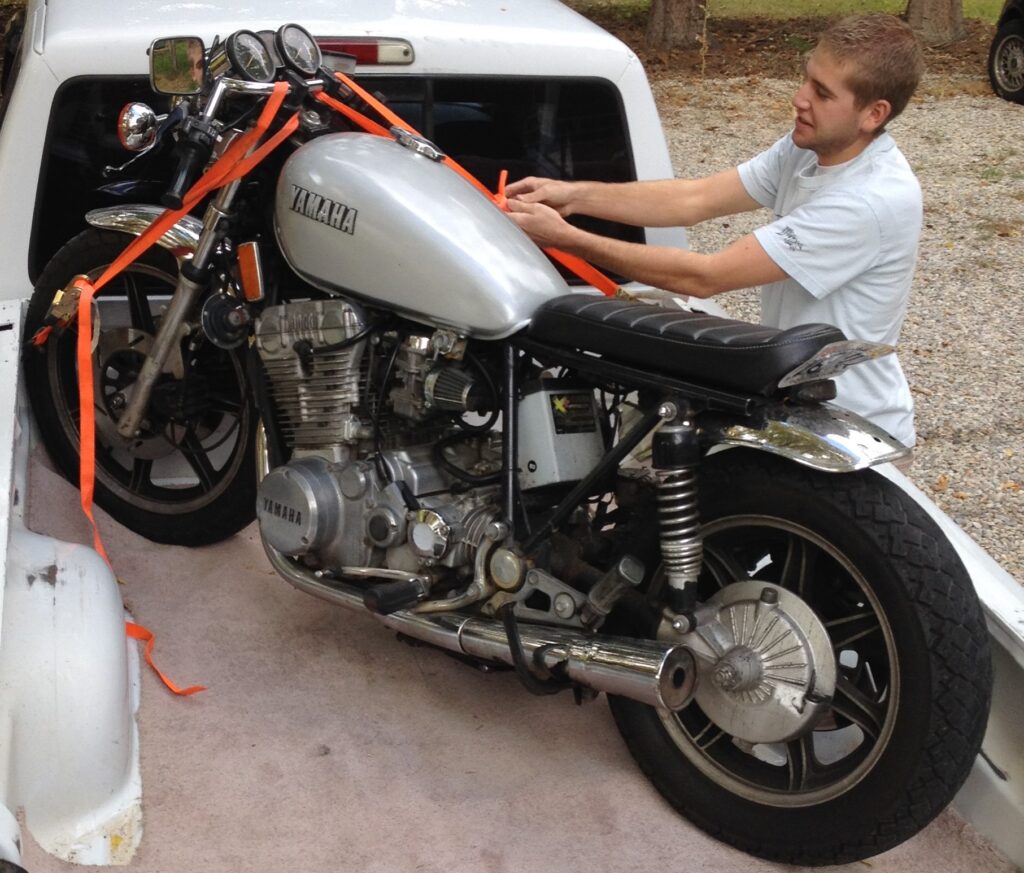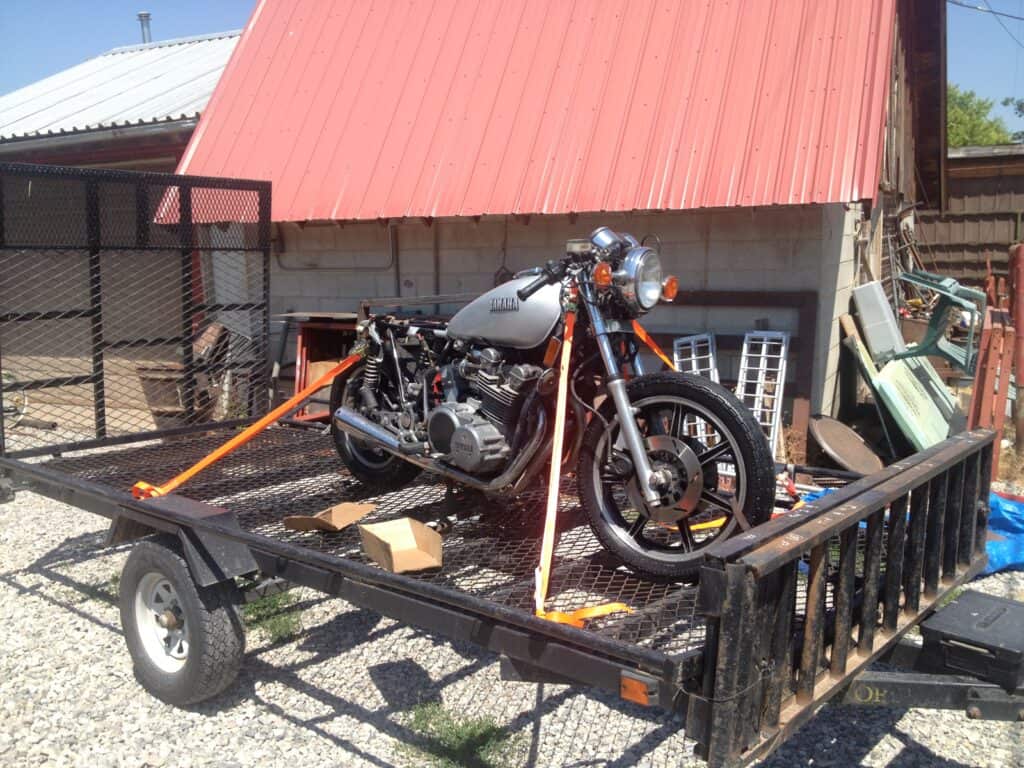
Figuring out how to move a motorcycle from point A to point B without actually having to ride it can sometimes be a little complicated. Though motorcycles are considered one of the smaller machines in the vehicle world, they can seem a lot bigger when you’re trying to move them around.
I’ve owned over a dozen motorcycles and have run into every problem imaginable with them including predicaments where I needed to transport them. I’ve compiled a helpful list for you to help you decide which method is the best way to transport your motorcycle.
Tow Dolly

If you’ve never seen or used a tow dolly before, you should definitely look into it especially if you don’t have a truck or trailer to normally rely on. This is an underestimated way to tow a motorcycle and can be incredibly easy to do with the right equipment.
A tow dolly is a strong metallic device that attaches to the hitch of a car. It connects to the front of a motorcycle tire and secures it to the back of a car. This will leave the back tire on the road so your car doesn’t have to carry the whole weight of the motorcycle.
A lot of people are skeptical about this method because it looks like it’s not very secure. In actuality, it’s quite secure when it’s hooked up to the device properly. It’s a good idea to use some tow straps to ensure it’s security and for your peace of mind. A lot of people have used this method and love it.
One of the nice things about having a tow dolly is it’s size. It’s something small enough that you can store in the corner of your garage with really no disturbance from it at all. That’s a lot better than having to store a trailer.
Another great thing about these is that you can use your smaller car; you don’t have to have a heavy SUV or truck to successfully transport your motorcycle using this method.
It does have specs you’ll need to pay attention too. The max load a tow dolly can haul is 800 pounds (this is the weight of the whole motorcycle even though it’s just connected to the front tire). But the average motorcycle usually weighs around 400 pounds, so most people should be fine using this method. Click here to see the specific tow dolly I recommend in my list of suggested ways of towing.
Motorcycle Carrier

If you’re uncomfortable with having half your motorcycle being rolled on the road while you tow it but still want another creative and space saving way to tow your motorcycle, a motorcycle carrier would be a good option.
A motorcycle carrier is a device that also connects to the hitch of your truck or SUV. It’s a ramp that you place the motorcycle on top of so the motorcycle is towed sideways on the back of your car. These are fairly easy to use and have proven to be an excellent way to transport a motorcycle.
The nice thing about using this method is that because it’s sideways against the back of your car, the precautions are much less compared to towing a trailer behind you. Of course you’ll want to be mindful with your driving while you have that back there, it’s just not as difficult or intensive.
These works excellently with an SUV, truck, or motor home and should only be used with a class III or class IV trailer hitch. It is not suggested you use these with a car smaller than an SUV because of the physics and weight distribution. The max amount of weight these can carry is 500 pounds. Again, the average motorcycle weighs about 400 pounds so most people should be fine using this method.
If you’re afraid your motorcycle weighs too much for the motorcycle carrier, you can try taking some large and heavy items off the bike such as side panels, windshields, luggage bags, etc. and put those in the back of your car. Click here to see the specific motorcycle carrier I recommend in my list of suggested ways of towing.
Van

Using a van is another underestimated way of transporting a motorcycle. It sounds a bit unconventional, but it has been done tens of thousands of times successfully and can work for you if you have the right equipment and the right van.
Obviously, this will only work if you have the right size of van and the right size of motorcycle. Mini vans have worked for some who have smaller motorcycles. There are rental vans out there big enough to fit motorcycles that also give you some room to walk around and secure it without bonking your head.
Whether it’s your van, a buddy’s van, or a rental van you are thinking of using, make sure to take measurements first before attempting to place the motorcycle inside. You’ll need a motorcycle ramp, some tow straps, a few blankets, and a tarp or some cardboard.
Before you place the motorcycle in the van, make sure the gas tank is completely empty. This will prevent gas from sloshing around, leaking, and emitting fumes that could be harmful for everyone inside the vehicle. Next you’ll want to place a tarp on the floor of the van to keep it from getting dirty.
Use the ramp to get the motorcycle inside the back of the van. It’s a good idea to have it against one side inside to keep it from moving around as much. You can use either blankets or pillows to put in between the motorcycle and the side to prevent scratches.
Use the tow straps to secure the motorcycle down snugly. You may need to get creative with where you fasten the two straps since most vans don’t come equipped with hooks for straps like this. Once the motorcycle is secure, you can place some cardboard underneath it to prevent leaks from running all over.
Rental Moving Truck

If you’re in a bind and need something pretty quick, renting a a small moving truck is a great option. These will offer a big space for your motorcycle to be transported safely.
I’ve used this method many times myself. There was a time while I was going to college and I didn’t have a truck to haul my motorcycles around (I was picking up a lot of non-running motorcycles from out of state to restore them). This was a perfect alternative and it worked great.
Large moving rental truck companies will often give you a great price for renting, especially if you pick up and drop off at the same place. For example, U-Haul will rent out a 10 foot truck (which is more than enough space for a motorcycle…or three) for about $20 a day plus about 80 cents per mile you drive it.
Say you have to use the truck for two days and put 50 miles on it. That will be $40 for the two days you have it plus about $40 for the mileage. Then you’ll need to pay for gas which will be about another $20. So altogether you will pay about $100 for the rental altogether.
$100 is a pretty good deal when you have a secure way of hauling your motorcycle that isn’t susceptible to the weather or debris from the road hitting it. Plus you’d be spending money on gas anyway no matter what method you’d be using to transport your motorcycle.
Shipping

If you want to transport your motorcycle in a way that doesn’t really mean much effort on your part, shipping a motorcycle is completely possible. Though this method will cost you more, it is a safe and effective way to get your motorcycle from one place to the next.
I have shipped several motorcycles across the U.S. When I was going to college, I restored motorcycles and sold them for a profit to help pay for my tuition. I ended up getting a few customers that were on the other side of the country and I shipped their finished motorcycle to them.
Each time I shipped a motorcycle, it cost around $900. One of those was going from Utah to Florida and the other one went from Idaho to New York. My customers were pleased with the condition the motorcycles came in, meaning they didn’t notice any damage at all.
If you’re going to use a shipping company, it’s a good idea to not go with the cheapest one. It’s okay to get a good deal on the shipping price, just don’t sacrifice the quality of the service to save a few bucks. You want one that’s reputable and will take good care of your motorcycle.
Reputable shipping companies do an excellent job at making sure your motorcycle is secure and well protected during the shipping process. They’re able to go from door step to door step, too. I always watch the employee load and secure the motorcycle when they come and pick it up.
As a little side note, when you start contacting some shipping companies, you’ll somehow end up getting a bunch of other shipping companies contacting you as well. I’m not sure how or why, but they do somehow get your phone number and try to get you to use them and their services. It’s just one of those annoying side notes you’ll have to deal with during a process like this.
Truck

Alright, I know that suggesting to use a truck to transport your motorcycle isn’t considered “creative,” but there are some creative ways to obtain a truck if you don’t have one but need one.
Like I had mentioned before, there was a while during my motorcycle restoration years that I didn’t have a truck. I had to get very creative with how I transported motorcycles after I bought them and when I sold them.
If you don’t have a truck, first check in with family or friends to see if they’d be willing to let you borrow one of theirs. You’d be surprised with how many people are willing to let you do so.
If no family or friends are around, the second option you have is to rent one. Again, a lot of moving truck rental companies have actual trucks you can rent instead of the huge moving trucks. Renting a truck from a rental moving company will be about $20 dollars a day (a direct quote from U-Haul) and about 80 cents per mile.
You can also simply rent a truck from a car rental company. For example, you can rent a truck from Enterprise for about $80 total for a day. That may seem a little expensive, but it’s something you have to resort to when you have no other option.
It’s always easiest to load a motorcycle into a truck that has been backed up to a small hill and to use a ramp to get the motorcycle in. The hill will make it so you don’t have to push the motorcycle up such a steep angle. Never use anything other than a designated ramp to get it in there.
Also make sure you always use strong towing straps to secure it down to the truck. Use at least four tow straps and be sure they are tight. Tie down any slack that’s left over on the straps so they’re not flailing in the wind and cause damage to either your motorcycle or passing cars. To learn more about how to securely fasten a motorcycle in the back of a truck, see our other article here.
Trailer

Again, this suggestion may seem like an obvious way to transport your motorcycle, but there are actually a ton of types of trailers out there that people think they can’t use because it’s not a “motorcycle trailer.” Any trailer that’s large enough to fit a motorcycle will do the job perfectly at transporting one, even if the trailer was meant for something else.
Trailers can easily attach to the back of a truck or SUV using a hitch. It does require some skill to haul a trailer so be sure to get some training before you decide to drive a vehicle with a trailer on the back.
Take the measurements of the motorcycle and the measurements of the trailer to ensure the motorcycle will fit if there’s any question of that. Be sure to fasten the bike down to the trailer using at least four two straps. It’s also a good idea to use some tire holders or stationary chocks to make sure the bike doesn’t roll back and forth. I have some tire holders that I suggest, you can see them here in my list of recommended ways of towing.
Tips For Transporting Your Motorcycle
Since we’ve discussed ways to transport a motorcycle in this article, I’d like to add a few tips you should know when doing so. These are tips I have learned throughout my motorcycle riding years.
If you are using a vehicle to tow your motorcycle either with a tow dolly, trailer, etc. make sure to know your car’s towing capacity beforehand. You should be able to see it on a sticker that’s inside the passenger door. When doing your calculations, consider the amount of people that will be in the car as well as any luggage you’ll be taking because that is considered weight that is being towed.
No matter how you are transporting a motorcycle, it’s always a good rule of thumb to stop every 50 – 75 miles to inspect the motorcycle and make sure it is secure. You may think it looks secure by glancing at it through your side or rear view mirrors, but those looks can be deceiving. It’s better to be safe than sorry on something like this.
Assume that the drivers around you have no idea that you are towing a motorcycle and drive accordingly. Leave plenty of space between you and other cars and double check before changing lanes. Go slower than normal so you don’t shake the motorcycle too much.
Any time you are tying down a motorcycle, make sure to never fully compress the shocks (also known as bottomed out) when tightening the straps. It’s good to compress the shocks some, but never do more than a 50% compression.
Transporting A Motorcycle On It’s Side
One common question I often run into when someone is transporting their motorcycle is if whether or not they can do so with the motorcycle on it’s side. This is something I don’t recommend because there are several things that can happen to the motorcycle.
First, gas will likely start leaking out of places it shouldn’t be in the first place. Such places may include the top through the gas cap. Gas can ruin paint on parts of your motorcycle if it finds it’s way there.
If the motorcycle is on it’s side long enough, hydrolock can start happening within in the engine. This is when oil starts seeping up past the piston rings and into the combustion chamber. This can either make starting your motorcycle difficult, make it smoke when it starts, or make it impossible to start in the first place.
If you don’t have a sealed battery, the battery can also leak battery acid. This is a substance you don’t want floating around because battery acid can be extremely corrosive. See my article here for more information about what happens when you lay a motorcycle on it’s side.
If you must lay a motorcycle on it’s side to transport it, you will need to empty all the fluids out of the motorcycle. And I mean all the fluids. This includes the gas, oil, coolant, and brake fluid. If you’re battery isn’t sealed, remove it and store it in an upright position during the ride.
Related Questions
What is the cheapest way to transport a motorcycle? The cheapest way to transport a motorcycle is by using equipment you already own and don’t need to rent. This includes using a truck, trailer, tow dolly, or motorcycle carrier. Towing a motorcycle will always come at a little cost because of the gas mileage you’ll get while doing so.
Can a motorcycle tow a trailer? It is completely possible for a motorcycle to two a trailer. Your motorcycle will need to have the capacity to do so, meaning it needs to have a bigger engine and a motorcycle trailer hitch needs to be connected to the motorcycle.
